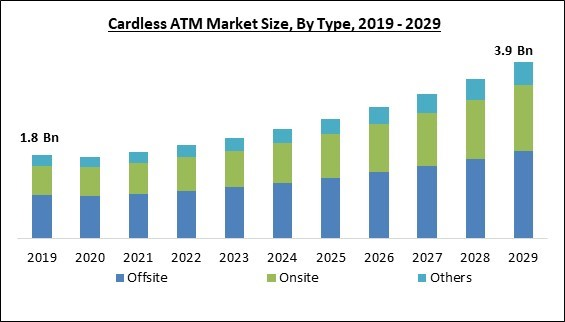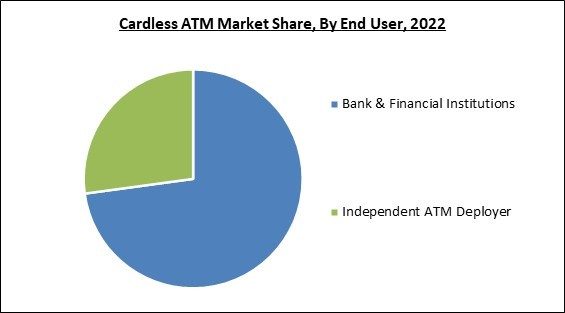The Global Cardless ATM Market size is expected to reach $3.9 billion by 2029, rising at a market growth of 9.8% CAGR during the forecast period.
Cardless ATM users can conveniently initiate withdrawals through their banking app and digitally locate nearby banks, ATMs, and other financial institutions. Furthermore, it lowers operational expenses related to teller services and minimizes the risk of fraudulent activities, thereby boosting the adoption of mobile banking. Moreover, this innovative strategy utilizing the current card rails enhances productivity and safety.
Cardless ATMs are a popular addition to bank locations as they offer customers the advantage of deposits, cash withdrawals, and transfers without the need for a physical card. Moreover, the increasing technological progress in IoT technologies, such as the incorporation of data analysis tools, is driving the expansion of the cardless ATM market. Furthermore, the increasing adoption of advanced smart ATMs that can be managed remotely is driving the need for cardless ATMs among customers, which is expected to boost the development of the cardless ATM market.
The digitalization of production procedures, quality control, maintenance, and other aspects of the manufacturing ecosystem through Industry 4.0 machines, technology, and equipment is revolutionizing the manufacturing industry. Incorporating cutting-edge technologies like IoT, AI, and big data into the production and manufacturing procedures of cardless ATM manufacturing can yield substantial advantages in terms of operational efficiency, security, connectivity, and customer satisfaction.
The market research report covers the analysis of key stakeholders of the market. Key companies profiled in the report include Fujitsu Limited, HSBC Holdings plc, Barclays PLC, ICICI Bank Ltd. (The ICICI group), Citigroup Inc., JPMorgan Chase & Co., Wells Fargo & Company, BANCO SANTANDER, S.A., NCR Corporation and GRGBanking Equipment Co., Ltd.
Cardless ATM users can conveniently initiate withdrawals through their banking app and digitally locate nearby banks, ATMs, and other financial institutions. Furthermore, it lowers operational expenses related to teller services and minimizes the risk of fraudulent activities, thereby boosting the adoption of mobile banking. Moreover, this innovative strategy utilizing the current card rails enhances productivity and safety.
Cardless ATMs are a popular addition to bank locations as they offer customers the advantage of deposits, cash withdrawals, and transfers without the need for a physical card. Moreover, the increasing technological progress in IoT technologies, such as the incorporation of data analysis tools, is driving the expansion of the cardless ATM market. Furthermore, the increasing adoption of advanced smart ATMs that can be managed remotely is driving the need for cardless ATMs among customers, which is expected to boost the development of the cardless ATM market.
The digitalization of production procedures, quality control, maintenance, and other aspects of the manufacturing ecosystem through Industry 4.0 machines, technology, and equipment is revolutionizing the manufacturing industry. Incorporating cutting-edge technologies like IoT, AI, and big data into the production and manufacturing procedures of cardless ATM manufacturing can yield substantial advantages in terms of operational efficiency, security, connectivity, and customer satisfaction.
COVID-19 Impact Analysis
The cardless ATM market experienced a downturn due to the COVID-19 pandemic, as several bank ATMs were closed during the lockdown period. The disruption of supply chains caused a significant decline in demand and sales, negatively impacting manufacturing, sales, and delivery schedules. Moreover, governments around the world implemented measures to prohibit the installation of new ATMs. The market's growth was impacted by the increasing preference of individuals towards UPI and other mobile transactions during the pandemic. Hence, the restrictions imposed during the pandemic led to a further decline in ATM transactions.Market Growth Factors
The rising utilization of biometric ATMs
In biometric technologies like fingerprint recognition, the user must initially press their finger onto the sensor for the system to function properly. In spite of this, worries regarding cleanliness are growing in various countries as a direct result of the spread of potentially fatal diseases like avian influenza, Ebola, and swine flu. On the other hand, to combat difficulties relating to the spread of contagious illnesses, vendors operating in the market for cardless ATMs have moved their focus to contactless biometrics. This includes the scanning of the retina and iris, as well as 3D facial recognition. As a result, an increase in the use of biometrics in the market for cardless ATMs would make new prospects for growth available to the vendors focusing on this market.The rising utilization of smartphones
The cardless cash solution allows customers to easily initiate transactions through their mobile banking app by utilizing a one-time code or QR code. The key players in this space are providing convenient and secure customer payment options. In addition, the offered solutions allow customers to utilize their smartphones for biometric authentication, including fingerprint or facial recognition. The various benefits offered by the cardless ATM, and its vendors and the rising penetration of smartphones are expected to surge the market growth.Market Restraining Factors
Strict regulations on contactless payment transactions
It is common for geographical regions to establish a set fee for each contactless transaction. The limitation on individual payments restricts users from conducting only minor transactions via NFC-enabled gadgets like smartphones, which is a disadvantage of cardless ATMs. Furthermore, the transaction limit is subject to change based on the clearance obtained from the relevant central banks. The limits have been implemented to mitigate the risk of fraud, as cardless payment devices are vulnerable to unauthorized access when ATMs are situated nearby. Nevertheless, these regulations are anticipated to restrict the market expansion throughout the projected period.Type Outlook
Based on type, the cardless ATM market is segmented into on-site, off-site, and others. The off-site segment dominated the cardless ATM market with maximum revenue share in 2022. This is because off-site cardless ATMs are a popular choice among customers due to their accessibility and convenience. Off-site cardless ATMs can be strategically placed in high-traffic areas, like airports, retail stores, and transportation places, to provide convenient access to customers. This service provides customers with a convenient way to access cash without the need to visit a physical bank or financial institution.Technology Outlook
On the basis of technology, the cardless ATM market is fragmented into near-field communication (NFC), quick response (QR) codes, and biometric verification. The near-field communication (NFC) segment held the highest revenue share in the cardless ATM market in 2022. This is because near-field communication (NFC) is a cutting-edge technology that enables users to transmit data wirelessly over a short range by holding up their mobile device to a receiver using radio frequency. Cardless ATMs equipped with NFC technology allow users to hold up their mobile devices with the mobile wallet or banking app open to the ATM's NFC receiver for a seamless transaction.End-user Outlook
By end user, the cardless ATM market is bifurcated into bank & financial institutions, and independent ATM deployer. The independent ATM deployer segment garnered a prominent revenue share in the cardless ATM market in 2022. This is owing to the fact that an independent ATM Deployer (IAD) is a business entity that owns, operates, and installs ATMs (cash machines) in various locations, including retail establishments. In addition, cardless ATM machine usage is increasing in various locations, such as metro stations, shopping malls, and co-working spaces, resulting in growth in this market segment in the projected period.Regional Outlook
Region wise, the cardless ATM market is analyzed across North America, Europe, Asia Pacific and LAMEA. The North America region registered the highest revenue share in the cardless ATM market in 2022. The growth of the regional market can be attributed to the well-established IT infrastructure, facilitating the integration of IoT-based devices in the BFSI sector, including smart ATMs. Furthermore, the market growth is being driven by the rising use of mobile banking and the growing concerns regarding ATM security.The market research report covers the analysis of key stakeholders of the market. Key companies profiled in the report include Fujitsu Limited, HSBC Holdings plc, Barclays PLC, ICICI Bank Ltd. (The ICICI group), Citigroup Inc., JPMorgan Chase & Co., Wells Fargo & Company, BANCO SANTANDER, S.A., NCR Corporation and GRGBanking Equipment Co., Ltd.
Scope of the Study
By Type
- Offsite
- Onsite
- Others
By End-user
- Bank & Financial Institutions
- Independent ATM Deployer
By Technology
- Near-field Communication (NFC)
- Biometric Verification
- Quick Response (QR) Codes
By Geography
- North America
- US
- Canada
- Mexico
- Rest of North America
- Europe
- Germany
- UK
- France
- Russia
- Spain
- Italy
- Rest of Europe
- Asia Pacific
- China
- Japan
- India
- South Korea
- Singapore
- Malaysia
- Rest of Asia Pacific
- LAMEA
- Brazil
- Argentina
- UAE
- Saudi Arabia
- South Africa
- Nigeria
- Rest of LAMEA
Key Market Players
List of Companies Profiled in the Report:
- Fujitsu Limited
- HSBC Holdings plc
- Barclays PLC
- ICICI Bank Ltd. (The ICICI group)
- Citigroup Inc.
- JPMorgan Chase & Co.
- Wells Fargo & Company
- BANCO SANTANDER, S.A.
- NCR Corporation
- GRGBanking Equipment Co., Ltd.
Unique Offerings
- Exhaustive coverage
- The highest number of Market tables and figures
- Subscription-based model available
- Guaranteed best price
- Assured post sales research support with 10% customization free
Table of Contents
Chapter 1. Market Scope & Methodology
Chapter 2. Market Overview
Chapter 3. Global Cardless ATM Market by Type
Chapter 4. Global Cardless ATM Market by End User
Chapter 5. Global Cardless ATM Market by Technology
Chapter 6. Global Cardless ATM Market by Region
Chapter 7. Company Profiles
Companies Mentioned
- Fujitsu Limited
- HSBC Holdings plc
- Barclays PLC
- ICICI Bank Ltd. (The ICICI group)
- Citigroup Inc.
- JPMorgan Chase & Co.
- Wells Fargo & Company
- BANCO SANTANDER, S.A.
- NCR Corporation
- GRGBanking Equipment Co., Ltd.
Methodology

LOADING...










